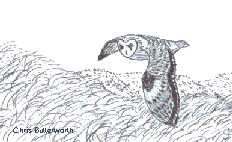|
Back to
Newsletter
Systematic list -
Mediterranean Gull to Great Black-backed Gull.
Kittiwake to Rock
Pigeon.
Stock Pigeon to Sand Martin (below).
Swallow to Wren.
Hedge Accentor to
Blackbird.
Fieldfare to Garden
Warbler.
Blackcap to Coal Tit.
Blue Tit to Chaffinch.
Greenfinch to Reed
Bunting.
Stock Pigeon
C. oenas
Scarce passage
4 in flight April 23rd. was the only record for the year.
[Hoylake Langfields holds good numbers during winter, as well as a small breeding population, but Stock Dove are not common on site. This may be because they are dismissed as 'just pigeons' when in flight.]
Common Wood Pigeon
C. palumbus
Resident
Peak count :- 32 September 12th.
At least 1 pair was present on site throughout the summer.
[ What was, at one time, a very nervous bird is now finding suburban gardens very much to its liking. The peak count was probably of birds moving to Hoylake Langfields, which holds a good sized flock throughout the winter. ]
Eurasian Collared Dove
Streptopelia decaocto
Resident
Peak count :- 42 March 27th.
Up to 4 birds present throughout the year.
[This boringly common species, unless you started birdwatching in the 1950's and 1960's then you probably remember the excitement of your first, has now spread to Iceland and has been rumoured to have bred in Canada ( and Florida, but all kinds of escapes breed in Florida! ) . The March birds are probably best regarded as being on short distance dispersal from their winter sites rather than true migration.]
European Turtle Dove
S. turtur
Vagrant
2 or 3 reported at Red Rocks May 12th.
[ Although Turtle Dove are recorded from Red Rocks occasionally ( not annually ) it is best regarded as a vagrant. The British population is in steep decline with a collapse in numbers even in its heartland of SE England. Turtle Dove has always been a scarce bird in Cheshire and Wirral and first bred in the 1860's. After a brief period of expansion and consolidation numbers started to fall in most parts of the county, leaving a few places such as Delamere Forest with regular breeding occurring.]
Common Cuckoo
Cuculus canorus
Scarce passage
1 May 4th. and 2 May 13th. in Red Rocks marsh were the only records for the year.
[ Why, when some of the most parasitised species nest in the area, are Cuckoo so scarce here? Practically all records are of birds in spring and there are very few of autumn juveniles. The only record last year was from April 29th. ]
Long-eared Owl
Asio otus
County Rarity
1 hunting over golfcourse and dunes October 13th. ( CB )
[ Although Long-eared Owls are undoubtedly less frequent than Short-eared's the main reason for them being classified as a County rarity is that both species can be easily confused. If attention is paid to the exact shape of the wings and tail and the amount, and extent, of streaking on the underparts, even high flying birds overhead can be identified. This is the first record for the wardens. Awaiting confirmation by CAWOS Rarities
Committee. ]

Short-eared Owl
Asio flammeus
Scarce winter visitor
Singles May 2nd., September 22nd., October 13th., 2 December 6th.
[In November there were large numbers of Short-eared Owls throughout the area and this was one of the best years ever recorded by the wardens on site. The May bird was watched at 1200 hrs. hunting over the dunes and was seen in the evening going to roost in Red Rocks marsh while the September bird was recorded as causing disturbance to the wader roost, the first time this species has been recorded as doing so by the wardens.]
Common Swift
Apus apus
Summer visitor
First :- 2 April 21st.
Peak count :- c.120 July 3rd.
Last :- 1 September 5th.
[ With over 100 pairs breeding in West Kirby this is a fairly common bird locally, but the numbers hunting over the dune slack in July this year were unprecedented. A possible reason being, the winds were very light this summer and prey was not being blown inland. The first bird was sighted on April 27th. last year with the final bird being seen flying towards the shore on October 13th. ]
Sky Lark
Alauda arvensis
Resident
Peak 1st. winter period :- 11 February 19th.
Peak 2nd. winter period :- 34 December 23rd.
There was a maximum of 16 singing birds between Red Rocks and West Kirby on April 3rd. 264 birds were reported on migration October 28th.
[ Numbers on the shore in the first winter period were severely depressed, probably as a continuation of last years figures, and the massive amount of disturbance during spring kept them low. Most of the birds that we normally see on the shore were probably in the large flock of > 130 on Hoylake Langfields. The peak number last year was 39 ]
Sand Martin
Riparia riparia
Passage migrant
First recorded :- 3 March 18th.
Peak count :- A minimum of 76 between 0600 and 0800 hrs. August 23rd.
Last recorded :- 1 September 4th.
[There were two peaks in spring migration this year. The first was on April 17th when 31 birds were counted passing through in the early morning, after which passage dropped off to less than one bird a day. On May 15th a minimum of 50 birds went through the site and numbers continued in double figures until the end of the month. During the first week in April the weather turned a bit grim and up to 7 Sand Martins at a time were seen heading south over the shore on 4 days. The extreme dates last year were March 21st. and September 19th.]
Swallow to Wren.
|
